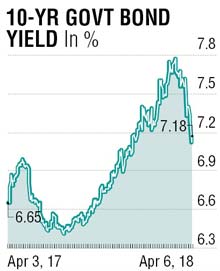
There may hardly have been a week like the one that went by if one rummaged through recent history. Trade frictions and insipid US jobs data, choppy equities across geographies, Reserve Bank of India's (RBI) MPC surprisingly less-hawkish than one feared, RBI finally acquiescing on the issue of amortisation of MTM losses and banks getting a shot in the arm, and to top it all – an increase in the FPI limit.
The Indian bond traders couldn’t have asked for more and it stands the test of reason that bond markets were mighty depressed to the point of virtual stay-off mode for future auctions, if not for these sops.
Global equities yet again remained choppy and in a downtrend due to the increasingly bellicose rhetoric from the US and Chinese officials on trade and tariffs. After some large see-saw moves, the week ended somewhat flat. Treasury Notes gave back early week gains as VIX softened to 20 from 22.50 previous week On the data front, the US non-farm payrolls grew at a fewer-than-expected 10,300 in alongside a downward revision to the previous months’ numbers by 50,000.

The unemployment rate held steady at 4.1%. Harsh winter is seen as a major cause for the disappointing numbers. That a Federal Reserve Governor frets over asset valuations relative to historical norms, and data that suggested global growth is somewhat slowing considering the expansionary pace seen in last many quarters, sends alert that volatility could remain high in coming months and 2018 could turn out to be an eventful year
Indian markets remained somewhat volatile to start the new financial year as this was one of the most headline-news driven weeks for a long time. To start with, RBI’s decision to allow forbearance for the trading losses among banks – where banks now get an opportunity to amortise it's December 2017 and March 2018 MTM losses in four quarters each, sent yields lower, in continuation of the recent bond rally post a market-friendly auction calendar. This was followed by an RBI-MPC where apart from keeping key rates unchanged, RBI also appeared to claw-back its hawkish tone. By lowering inflation expectations in both the half-years of FY 2019, the committee sends signals that a hike may remain a distant event.
While that is for the headline readers, caution would be a better strategy as any of the following events viz. an unexpectedly larger MSP hike, disappointing monsoon or flare up in crude prices may push MPC towards a hawkish bias. The way HRA has been part of and not part of CPI calculations warrants wariness. Importantly, from a fundamental viewpoint, the committee assessment is that growth has been recovering and output gap closing as evidenced by recent credit growth numbers.
From a market standpoint, while the policy and other recent announcements have provided some extra momentum to the recent rally, valuations are less attractive relative to last few months. The curve and term spreads are flattening in the mid and longer tenors and therefore more interest now would be at the shorter end where carry and low-risk strategies may pay rich dividends.
The rupee continues to remain stronger and should benefit from the limit increase for FPI in debt. RBI announced an half-a-percentage point increase for each of the two financial years FY 2019 and FY 2020. For the current year, this would translate into roughly Rs 60,000 crore foreign demand for Indian debt and should ideally ease supply pressure. With country’s foreign exchange reserves touching another all-time high record, one can expect some sterilized intervention in the coming days.
In essence, the spate of measures during the last week appears more towards addressing the undue spike in yields. The authorities would like to anchor the yields to a fair-value of around 7% with spreads getting determined by demand-supply and liquidity mismatches. Under the circumstances, a 7.10-7.30% within a 6.95-7.45% broader range should play out in H1. In the immediate future, a test of 7.10 is likely.
The writer is a market expert